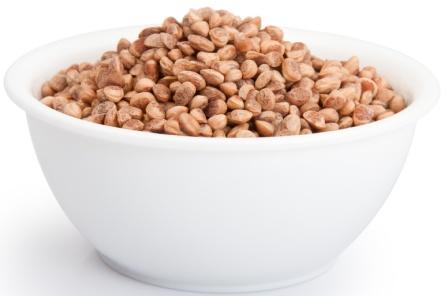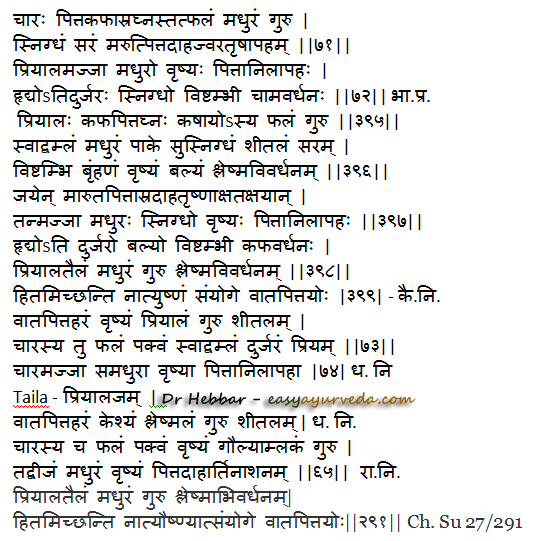Chironji – Buchanania lanzan Uses, Dose, Side Effects
Chironji – Buchanania lanzan, Charoli is called Priyala in Ayurveda. It is used as a cooking spice. It is aphrodisiac, nourishing, cardiac tonic but it may cause indigestion.
Botanical name- Buchanania Latifolia Roxb (Buchanania lanzan Spreng)
Family –Anacardiaceae
Table of Contents
Vernacular names
Names in different languages:
Hindi name- Chironji चिरौन्जी, Chirounji, Chiraunji, Charoli, Priyal, charoli, chiraunji, chironji, kath bhilawa.
Gujarati name- Charoli, चारोळी
Tamil name- Karaka, சாரப்பருப்பு, saaraparuppu, saarai paruppu, caraiparuppu, pulimaangay.
Telugu name- Sara chettu, Morli, chaara, chaarumaamidi, saaraparuppu.
Kannada name- Nurkal, chaaraparuppu, chirapuli
Malayalam name – cheru, kalamavu,mungalperlu.
Urdu name – chironji.
Persian name – nakulekwajah.
Arab name – chironji, habulsamnah.
Marathi name – char, chareli, charoli, chronji.
English name – almondette, cheronjee, cuddapah almond.

Medicinal qualities
Chironji medicinal qualities:
Guna (qualities) –Snigdha – unctuous, oily, Guru (heaviness), Sara – induces mobility, causes diarrhea, purgation, relieves constipation
Rasa (taste) – Madhura – sweet
Vipaka- Madhura – sweet
Veerya – Sheeta – Coolant
Effect on Tridosha: Balances Vata and Pitta
The marrow of priyala is sweet and aphrodisiac. It treats vitiation of pitta and vata dosha, is cardio tonic, unctuous, causes constipation, is difficult to digest and increases ama.
Part used, dosage
Part used– Stem bark, Chironji nuts, seed kernel
Dosage- Bark decoction 50-100 ml
Seed kernel – 10 – 20 grams per day. It can be eaten raw or after roasting or after frying with any cooking oil.
How to use chironji –
It can be consumed raw or roasted and used as an ingredient in cooking / dishes.
For weight loss, Charoli is dry roasted. 5 grams of this is taken with 1 – 2 teaspoons of honey, once or twice a day.
Sanskrit verse

Health benefits, uses, indications
Health Benefits Of Chironji:
Bark – Balances Pitta and Kapha Dosha,
Asraghna – useful in blood disorders such as abscess, skin disorders, bleeding disorders such as menorrhagia, nasal bleeding etc.
Chironji nut uses:
Madhura – sweet
Amla – sour
Madhura Vipaka – undergoes sweet taste conversion during digestion process
Guru – heavy to digest
Snigdha – unctuous, oily
Sara – induces mobility, causes diarrhea, purgation, relieves constipation
Balances Vata and Pitta Dosha
Indicated in:
Daha – burning sensation, as in gastritis, neuropathy, burning sensation in eyes etc
Jwara – fever
Trushna – excessive thirst
Brumhana – nourishing, nutritious
Vrushya – aphrodisiac, improves visor
Balya – improves strength and immunity

Charoli seed / seed kernel uses
Madhura – sweet
Vrushya – aphrodisiac, improves vigor
Balances Vata and Pitta Dosha
Hrudya – acts as cardiac tonic, congenial for heart
Atidurjara – difficult to digest
Snigdha – unctuous, oily
Vishtambhi – may cause constipation
May cause Ama – A product of indigestion and altered metabolism
Chironji oil
Chironji oil – Priyala Taila
Madhura – sweet
Madhura Vipaka – Undergoes sweet taste conversion during digestion process
Guru – heavy to digest
Increases Kapha Dosha
Keshya – Improves hair strength, promotes hair growth
Sheetala – coolant
Balances Vata and Pitta
Abhishyandi – sticks to the inner channels
Srushta mutra – acts as diuretic
Agnisada – may cause indigestion
Chironji oil is applied on hair to relieve gray hairs.
Chironji is used in making a dish called Shashkuli (Called Chakkuli in Kannada), along with other ingredients like black gram, ash gourd pulp etc – reference: Kaiyadeva Nighantu, Krutaanna Varga
Chirounji (Buchanania lanzan) mitigates vata effectively, is unctuous, cold in potency; its marrow is sweet, aphrodisiac,mitigates pitta and vata,
Kola majja (fleshy part of the ber fruit) is similar in properties with priyala majja (Seed kernel) relieves thirst, vomiting and cough. Ashtanga Hridaya Sutrasthana 6/124
Charaka Sutrasthana 27/291
Oil of Priyala (Buchanania lanzan Spreng) is sweet in taste, heavy and aggravator of Kapha. Since it is not very hot, it is useful when Vata and Pitta are jointly aggravated. Charaka Sutrasthana 27/291
Chironji for skin
Chironji seeds along with other herbs like Tinduka, Manjishta (Rubia cordifolia), Usheera (Vetiver) etc. are processed to prepare an oil, useful in treating Sadyovrana – acute ulcers and wounds.
Seed powder is used for Udvartana (powder massage) to slough debridement (remove top layer) in skin diseases.
The priyala seeds acquired from priyala fruit are colloquially known as saara paruppu in Tamil; as chronji in Hindi. The priyala fruit is commonly known as Apricot fruit in English.
The Apricot fruit is sweetish in taste. It nourishes the tissues and increases virility
The epicarp of the apricot aggravates the pitta dosha.
The pulp or mesocarp of the apricot fruit is sweetish in taste, pleasant to eat, and appeases the pitta doSha.
Side effects
It is not good to consume nuts or seeds while having indigestion and problem during constipation.
It is used during pregnancy, lactation and in children.
Interaction with medicines, supplements
Can this be used while taking Homeopathic medicine?
Yes. This product does not react with homeopathic medicine.
Can this medicine be continued while taking supplements like multivitamin tablets, Omega 3 fatty acids etc?
Yes. Generally, this product goes well with most dietary supplements. However, if you are taking more than one product per day, please consult your doctor for an opinion.
With western
medicines
Seek your
doctor’s advice if you are taking this product along with other western
(allopathic / modern) medicines. Some Ayurvedic herbs can interact with modern
medicine.
If both Ayurvedic and allopathic medicines are advised together, then it is
best to take Allopathic medicine first, wait for 30 minutes and then take the
Ayurvedic medicine.
Ayurvedic medicines
Ayurvedic medicines with Charoli as ingredient:
Chandanadi Taila – a natural coolant oil. It is used to relieve burning sensation, dizziness, etc.
Ashoka Ghrita – Herbal ghee used in gynecological disorders.
Pugakhand – used in the treatment of gastritis and related complaints.
Research
Wound healing activity of methanolic extract
Antiulcer activity of ethanolic extract of roots
Sanskrit synonyms
Khara skandha – stem is rough to touch
Sannakadru – the tree bends forward
Dhanushpata – bark is used to prepare cloth for bows.
Chara, Dhanuspata, Rajadana,
Bahula valkala – has thick bark
Tapasesta – Liked by sages
Dhanushpata, Drakshaphala, Munipriya, Amlaphala, Lalana, Khadru,
Snehabeeja – seed yields oil
Chemical composition
Buchanania lanzan chemical composition
Kaempferol
Leaves – flavonoids and glycosides
Classical categorisation
Charaka-
Udarda prashamana – group of herbs useful in allergic skin diseases
Shramahara – group of herbs useful to relieve tiredness,
One among 26 Phala Asava Yoni – fruit source of alcoholic preparations
Sushruta- Nyagrodhadi gana, Kakolyadi Gana, Phalavarga,
Kaiyadeva Nighantu – Oshadhi Varga
Raja Nighantu, Bhavaprakasha, Dhanvantari Nighantu – Amradi Varga
Sthanika Karma (Systemic Action)
External –Beneficial in skin disorders, improve complexion, reduce edema, give colour to hair. External application of the powder is beneficial in skin disorders. Oil can be applied in conditions like abscess, graying of hair etc.
Nervous System – Strengthen the nervous. Indicated in vataja rogas, headache, giddiness etc.
Digestive system – Indicated in thirst and constipation
Circulatory System – Indicated in blood borne diseases and weakness of heart
Respiratory system – Gruel can be given in cough
Excretory system – Indicated in Dysuria, pus in urine, and in burning micturition
Satmikarana – Indicated in general debility
Skin – Indicated in Skin disorders, burning sensation, and in allergic skin lesions.
Tapakrama – beneficial in Fever (Jirna jvara)










